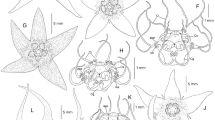Abstract
Melanopsidium is a poorly known monospecific genus, represented by dioecious shrubs endemic to Brazilian restingas. Its systematic relationships have been considered ambiguous by some authors, but recent phylogenetic studies strongly support its position in the tribe Gardenieae, and more precisely within the “Alibertia-group”. Its complex taxonomic history, full description, lectotypification, synonymy, and biogeographic observations are presented; original plates here selected as lectotypes are reproduced; staminate and pistillate flowers are illustrated; and a distribution map is included.
Similar content being viewed by others
Literature Cited
Araújo, D. S. de. 1997. Cabo Frio Region, South Eastern Brazil. Pages 373–375.In: WWF & IUCN, Centres of plant diversity. A guide and strategy for their conservation. Vol. 3. The Americas. IUCN Publication Unit, Cambridge.
Baillon, H. E. 1880.Billiottia. Hist. Nat. Pl., vol. 7: 313, 437–438. L. Hachette, Paris.
— 1881.Billiottia, Nat. Hist. Pl., vol. 7: 313, 437–438. L. Reeve, London (English translation of Baillon, 1880).
Braun, A. 1855.Pleurocarpus. Pages 60–61.In: De Algis unicellularibus, nonnullis novis cognitis. Typis Academicis, Berlin.
Candolle, A. P. de [Sep] 1830.Billiottia. Prodromus systematis naturalis, vol. 4: 618. Treuttel & Würtz, London.
Cels, F. 1817. Catalogue des arbres, arbustes, et autres plantes de serre chaude, d'orangerie et de pleine terre. … Imprimerie de Feugueray, Paris.
Colla, L. 1824. Hortus ripulensis, enumeratio plantarum quae ripulis coluntun Ex regio typographaeo, Torino.
— “1825” [1826]. Mémoire sur leMelanopsidium nigrum des jardiniers, et formation d'un genre nouveau dans la famille des Rubiacées: 1–16, pl. 1. De Lebel, Paris.
— 1826. Mémoire sur une Rubiacée nommée par le jardiniersMelanopsidium nigrum, et formation d'un genre nouveau sous le nom deViviania. Mém. Soc. Linn. Paris 4: 15–27, pl. 2.
Correia, C. M. B. 1998. Estrutura de populações, associação entre quatro espécies-chaves e formação de moitas em restinga deClusia, no norte fluminense. Masters thesis, Universidade Federal do Rio de Janeiro, Rio de Janeiro.
Delprete, P. G. 1999.Riodocea (Rubiaceae, Gardenieae), a new genus from the Brazilian Atlantic forest. Brittonia 51: 15–23.
Endlicher, S. 1843.Rhyssocarpus pubescens. Plantae hortenses descripsit Stephanus Endlicher. Bot. Zeitung (Berlin) 1: 459.
Hooker, J. D. 1873. Ordo LXXXIV. Rubiaceae.In: G. Bentham & J. D. Hooker, editors. Genera Plantarum ad exemplaria imprimis in herbariis kewensibus servata definita, 2: 7–151. Lovell Reeve, London.
Klotzsch, F. 1859.Pleurocarpus decemfidus, eine neue Rubiacee aus der Tribus Hamelieae. Bonplandia (Hanover) 7: 3–4.
Lacerda, L. D. de, D. S. D. de Araújo &N. C. Maciel. 1982. Restingas brasileiras: uma bibliografia. Fund. José Bonifácio, Rio de Janeiro.
——,R. Cerqueira &B. Turcq, editors. 1984. Restingas: origem, estrutura, processo. CEUFF, Niterói.
—,D. S. D. de Araújo &N. C. Maciel. 1993. Dry coastal ecosystems of the tropical Brazilian coast.In: E. van deer Maarel, editor. Ecosystems of the world. Vol. 2B. Dry coastal ecosystems: Africa, America, Asia and Oceania. Elsevier, Amsterdam.
Loddiges, C. 1818. Catalogue of plants, which are sold by Conrad Loddiges and sons, nurserymen, at Hackney, near London. Ed. 11, W. Wilson, Hatton-Garden.
— 1820. Catalogue of plants. … Ed. 12. W. Wilson, Hatton-Garden.
— 1823. Catalogue of plants. … Ed. 13. W. Wilson, Hatton-Garden.
Persson, C. 1993. Pollen morphology of the Gardenieae-Gardeniinae (Rubiaceae). Nordic J. Bot. 13: 561–582.
— 1996. Phylogeny of the Gardenieae (Rubiaceae). Bot. J. Linn. Soc. 121: 91–109.
— 2000. Phylogeny of the neotropicalAlibertia group (Rubiaceae), with emphasis on the genusAlibertia, inferred from ITS and 5S ribosomal DNA sequences. Amer. J. Bot. 87: 1018–1028.
Persson, C. In press. Phylogeny of Gardenieae (Rubiaceae) based on chloroplast DNA sequences from the rps 16 intron and trnL(UAA)-F(GAA) intergenic spacer. Nordic J. Bot.
Richard, A. “1829” [Dec 1830]. Mémoire sur la famille des Rubiacées. Imprimerie de J. Tatsu. Paris. (Reimpr. Mém. Soc. Hist. Nat. Paris, ser. 3, 5: 81–224. 1834.)
Rizzini, C. T. 1977. Tratado de fitogeografia do Brasil. Hucitec, Ed. Universidade de São Paulo, São Paulo.
— 1997. Tratado de fitogeografia do Brasil: aspectos ecológicos, sociológicos e florísticos. Ed. 2, rev. by C. M. Rizzini. Âmbito Cultural Edições, Rio de Janeiro.
Robbrecht, E. 1988. Tropical woody Rubiaceae. Characteristic features and progressions. Contributions to a new subfamilial classification. Opera Bot. Belg. 1: 1–271.
— 1993 [1994]. Supplement to the 1988 outline of the classification of the Rubiaceae. Index to genera. Opera Bot. Belg. 6: 173–196.
Robbrecht, E. &C. Puff. 1986. A survey of the Gardenieae and related tribes (Rubiaceae). Bot. Jahrb. Syst. 108: 63–137.
Schumann, K. 1888. Über eininge verkannte oder wenig gekannte Geschlechter der Rubiaceen Südamerikas. Bot. Jahrb. Syst. 10: 302–363.
— 1889.Melanopsidium.In: C. F. P. Martius & A. G. Eichler, editors. Flora brasiliensis 6(6): 371–373, fig. 148. Fleischer, Leipzig.
— 1891.Melanopsidium.In: A. Engler & K. Prantl, editors. Die Natürlichen Pflanzenfamilien 4(4): 83, fig. 30A-E. Engelmann, Leipzig.
Silva, M. B. R. da. 1991. Fitossociologia da vegetação lenhosa de restinga em Maricá, Rio de Janeiro. Master thesis, Universidade Federal do Rio de Janeiro, Rio de Janeiro.
Stafleu, F. A. &R. S. Cowan 1986. [Vellozo]. Pages 696–699.In: Taxonomic literature. Vol. VI. Ed. 2. Bohn, Scheltema & Holkema, Utrecht.
— &E. A. Mennega. 1997. Taxon. Lit., Suppl. 4: Ce-Cz. Koeltz Scientific, Königstein.
Vellozo, J. M. da C. Gardenia ferrea. “1825” [1829]. Flora fluminensis, seu descriptionum plantarum praefectura fluminensi…, 103. Ex Typographia nationali, Rio de Janeiro.
—.Gardenia ferrea. “1827” [1831]. Flora fluminensis icones, vol. 3: tab. 13. Edidit Domnus Frater Antonius da Arrabida, Publicaeque Bibliothecae in Urbe Fluminensis praefectus. Lithogr. Senefelder, Paris.
Author information
Authors and Affiliations
Rights and permissions
About this article
Cite this article
Delprete, P.G. Melanopsidium Colla (Rubiaceae, Gardenieae): a monospecific Brazilian genus with a complex nomenclatural history. Brittonia 52, 325–336 (2000). https://doi.org/10.2307/2666585
Issue Date:
DOI: https://doi.org/10.2307/2666585




